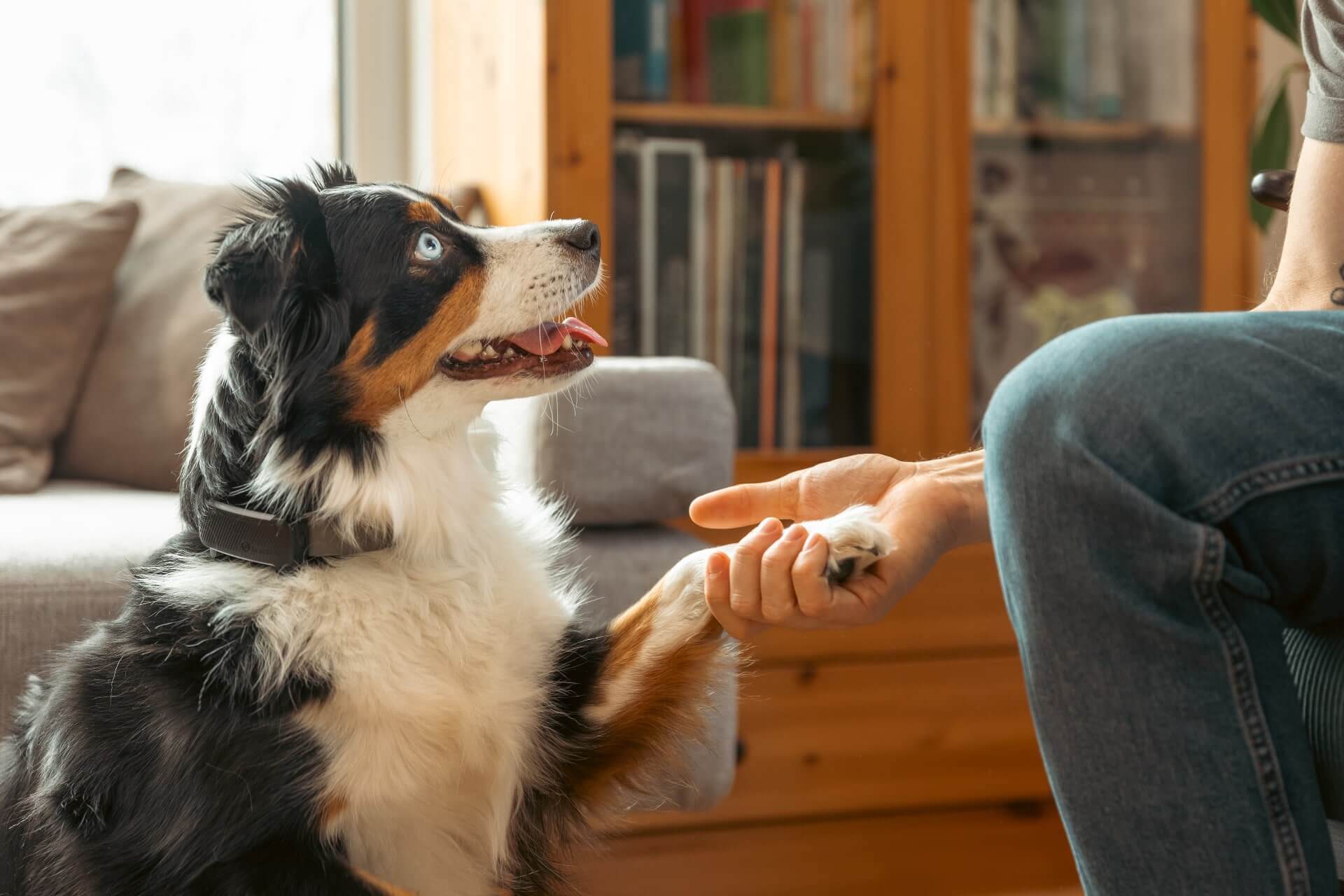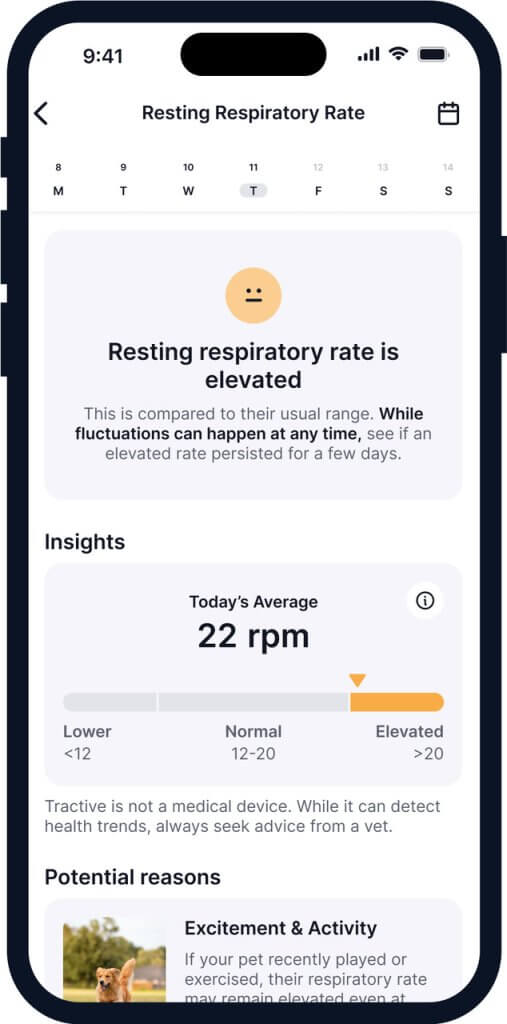 Approved by Dr. Dwight Alleyne, DVM
Approved by Dr. Dwight Alleyne, DVM Why is My Dog Shaking? Understanding the Shivers
Just like humans, dogs can shake for a variety of reasons. Here they are - and which ones signal a red flag.

You wouldn’t be the first to be alarmed seeing your dog shaking, trembling, or panting excessively. So if you’ve landed here looking up, “Why is my dog shaking?”, we’ve got you covered. Let’s dive into the common reasons why, when it’s time to call the vet, and how a smart dog tracker with vital signs monitoring can prevent an emergency.
Key Takeaways
Common causes for a dog shaking include excitement, cold, anxiety, or attention-seeking – but it can also signal serious medical issues.
Shaking accompanied by panting often indicates stress, pain, or potentially life-threatening conditions like heatstroke.
Head to your vet right away if the shaking is sudden, severe, persistent, or combined with symptoms like vomiting, lethargy, collapse, or signs of poisoning.
Smart dog trackers like Tractive can help you monitor your dog’s vital signs, activity, and sleep, providing early alerts for potential health problems.

Always know your buddy is healthy & safe
Read moreWhy is my dog shaking so much? The more common reasons
Sometimes, your dog’s shivers are completely normal and nothing to worry about. It could be due to excitement or happiness – especially among younger dogs. But it could also be due to:
- The cold
Just like us, dogs shiver when they’re cold. This involuntary muscle contraction helps generate heat to warm them up. Short-haired breeds, puppies, and older dogs are more susceptible to the cold. If it’s chilly outside or your house is cool, a blanket or a cozy sweater might be all they need. - Anxiety, fear, or stress
This is a very common reason for shaking, often accompanied by panting, whining, hiding, or flattened ears. Loud noises (fireworks, thunderstorms), new environments, separation anxiety, or unfamiliar people can all trigger a fear response. Their body releases adrenaline, preparing them to “fight or flight,” which can manifest as trembling. Creating a calm environment and offering reassurance can help. - Seeking attention
Some clever pups learn that shaking gets your immediate attention. If you rush to comfort them every time they tremble, they might start doing it to get extra cuddles or treats.
💡A smart dog tracker with Health Monitoring (like Tractive) can help you monitor your dog’s vital signs. I.e., their breathing rate and heart rate, which could often be elevated when they’re in the middle of a shaking fit. So you can catch on to the signs early and bring them over to a vet for a checkup before they get worse.

Get health alerts for your dog
Our pups can’t always tell us if something’s wrong. But if their tracker detects unusual changes in their routine, you’ll get an alert, helping you catch potential issues early.
Medical reasons your dog might be shaking & trembling
Trembling can also be a symptom of an underlying medical condition. Like, for example:
- Pain or discomfort
If your dog is in pain from an injury, arthritis, or an internal issue, they might tremble. Look for other signs like limping, whining, reluctance to move, or sensitivity to touch. Older dogs are particularly prone to shaking due to arthritis. - Nausea
An upset stomach can cause shaking, often along with other symptoms like drooling, vomiting, or loss of appetite. - Generalized Tremor Syndrome (GTS) / “White Shaker Syndrome”
This condition, often seen in small, white dog breeds (though it can affect any dog), causes full-body tremors. It’s thought to be an autoimmune condition and can often be managed with medication. - Hypoglycemia (Low blood sugar)
This is more common in puppies, small breeds, or diabetic dogs. Shaking, weakness, disorientation, and even collapse can be signs of low blood sugar. - Poisoning
If your dog suddenly starts shaking severely, especially if accompanied by drooling, vomiting, diarrhea, lethargy, or seizures, they may have ingested something toxic. Common culprits include chocolate, xylitol (in sugar-free products), certain plants, medications, or pesticides. - Seizures
While often distinct from general shaking, some seizures can manifest as rhythmic jerking or trembling. During a seizure, your dog might lose consciousness, paddle their legs, or lose bladder control. - Addison’s Disease
This is a hormonal disorder where the adrenal glands don’t produce enough hormones. Symptoms can include shaking, weakness, lethargy, vomiting, and diarrhea. - Distemper
A serious viral disease, distemper can cause shaking, coughing, fever, lethargy, and vomiting, especially in unvaccinated puppies. - Fever
Just like humans, dogs can shiver when they have a fever as their body tries to raise its temperature to fight off an infection or inflammation.
Why is my dog shaking and panting?
When shaking is accompanied by panting, it could be because of:
- Anxiety or fear
Panting is a common stress response in dogs, helping them cool down when their body temperature rises due to stress or excitement. If your dog is shaking and panting during thunderstorms, fireworks, or vet visits, it’s likely due to fear or anxiety. - Pain
Dogs in significant pain may pant excessively as a coping mechanism, alongside shaking or trembling. This can be a sign of internal discomfort, injury, or chronic conditions like severe arthritis. - Heatstroke
This is a life-threatening emergency and warrants an immediate vet visit. If your dog is shaking, panting heavily, drooling, has bright red gums, appears disoriented, or collapses, they could be suffering from heatstroke. - Nausea/Upset stomach
When a dog feels nauseous, they might shake and pant as part of their discomfort. This can precede vomiting or diarrhea. - Certain medical conditions
Conditions like Addison’s disease, hypoglycemia, or even some neurological issues can present with both shaking and panting as symptoms. If these symptoms appear suddenly and severely, it’s crucial to consult a vet.
When to head to your vet
It’s always best to consult your vet if you’re unsure about the cause of your dog’s shaking, especially if it’s new, persistent, or accompanied by other concerning symptoms. But drop by for a checkup right away if your dog’s shaking is sudden and severe and accompanied by:
- Vomiting
- Diarrhea
- Lethargy
- Unresponsiveness
- Difficulty breathing or excessive panting without exertion
- Collapse or loss of consciousness
- Signs of pain (whining, limping, guarding a body part)
- Seizures (rhythmic jerking, loss of control)
- Unusual drooling (which might indicate poisoning)
- Changes in gum color (pale or blue)
- Disorientation or confusion
⚠️ Other red flags include if the shaking doesn’t resolve quickly. (Like, for example, after warming up, calming down, or resting).
How might my vet treat my dog’s shaking?
Your vet will recommend treatment based on what’s causing it:
| Medical condition | Treatment |
| Pain | Your vet may prescribe pain medication, anti-inflammatory drugs, or recommend physical therapy. |
| Hypoglycemia | Emergency treatment involves administering glucose. For ongoing management, dietary changes or medication may be necessary. |
| Poisoning | This requires immediate veterinary intervention to induce vomiting, administer activated charcoal, or provide other supportive care depending on the toxin. |
| Seizures | Your vet will work to diagnose the cause of seizures and may prescribe anti-seizure medication to manage them. |
| Generalized Tremor Syndrome | Often treated with corticosteroids. |
| Other medical conditions | Your vet might prescribe specific treatments based on the diagnosis (e.g., medication for Addison’s disease, antibiotics for infections). |
How can I calm down my dog if they’re shaking?
If you’ve ruled out a medical emergency, there are several things you can do to help them calm down. A quiet, comfortable area where your dog can retreat can work wonders. This could be their crate (if they’re crate-trained and view it as a safe haven), a cozy bed in a low-traffic area, or a designated corner of a room.
If you can identify what’s causing their anxiety (e.g., loud noises, a new person, a specific object), try to remove them from the situation or minimize their exposure. Close windows during thunderstorms, put on calming music, or gently guide them away from the trigger. For some dogs, gentle petting, soft words, or a reassuring presence can be very calming. However, avoid overly coddling or reinforcing the anxious behavior. If your dog prefers space, respect that.
Distracting your dog with a favorite toy, a puzzle feeder, or a short, gentle play session can also redirect their focus and help them relax. Else, calming aids like thundershirts or anxiety wraps can provide gentle, constant pressure that can help calm them down. Some pheromone diffusers can also help reduce anxiety. Your vet can also best guide you on whether your dog could benefit from oral medication or calming supplements.
Finally, don’t skip out on your routine of walks, playtime, and training together. A well-exercised, mentally active dog is generally calmer – and will benefit from the stability of a routine. The key is to observe your dog’s individual cues and respond in a way that truly helps them feel safe and secure.
How a smart dog tracker can prevent an emergency
Your dog isn’t likely to complain when they’re stressed, in pain, or ill. That’s where technology can lend a hand. A smart dog tracker like Tractive goes beyond just location tracking. It can provide invaluable insights into your dog’s well-being, helping you spot potential issues early.

Strapped to your dog’s collar, you can now:
- Keep track of your dog’s vital signs
Like their resting heart rate and resting respiratory rate. Subtle changes in these vitals can be early indicators of stress, pain, or illness, often before more obvious symptoms appear.

- Spot potential health issues before they arise
If there’s a change in your dog’s activity and sleep patterns, you’ll get a Health Alert. These are crucial, especially since dogs are masters at hiding discomfort or pain. So you can get them to a vet and potentially catch on to a health problem sooner rather than later.
Seeing your dog shake can be worrying. But by watching out for any other symptoms and understanding what’s causing them, you can better figure out if it’s normal or a red flag. When in doubt, always get in touch with your vet. They’re your best resource for ensuring your dog’s health and well-being.
Your furry friend’s health and wellbeing means as much as to us as it does to you. So we’ve made it a priority to only share medically-relevant content on our blog. This post was checked, double-checked, and medically verified by Georgia-based vet, Dr. Dwight Alleyne.

Dr. Dwight Alleyne, DVM
Originally from Long Island, New York, Dr. Alleyne began his career at a no-kill animal shelter before becoming a licensed veterinary technician. He graduated from Cornell University Veterinary College in 2006 and completed an internship at Purdue University. Now practicing in Georgia, Dr. Alleyne specializes in soft tissue surgery and ultrasounds. He also writes pet health articles on his website, “The Animal Doctor Blog” (www.anmldrblog.com).




